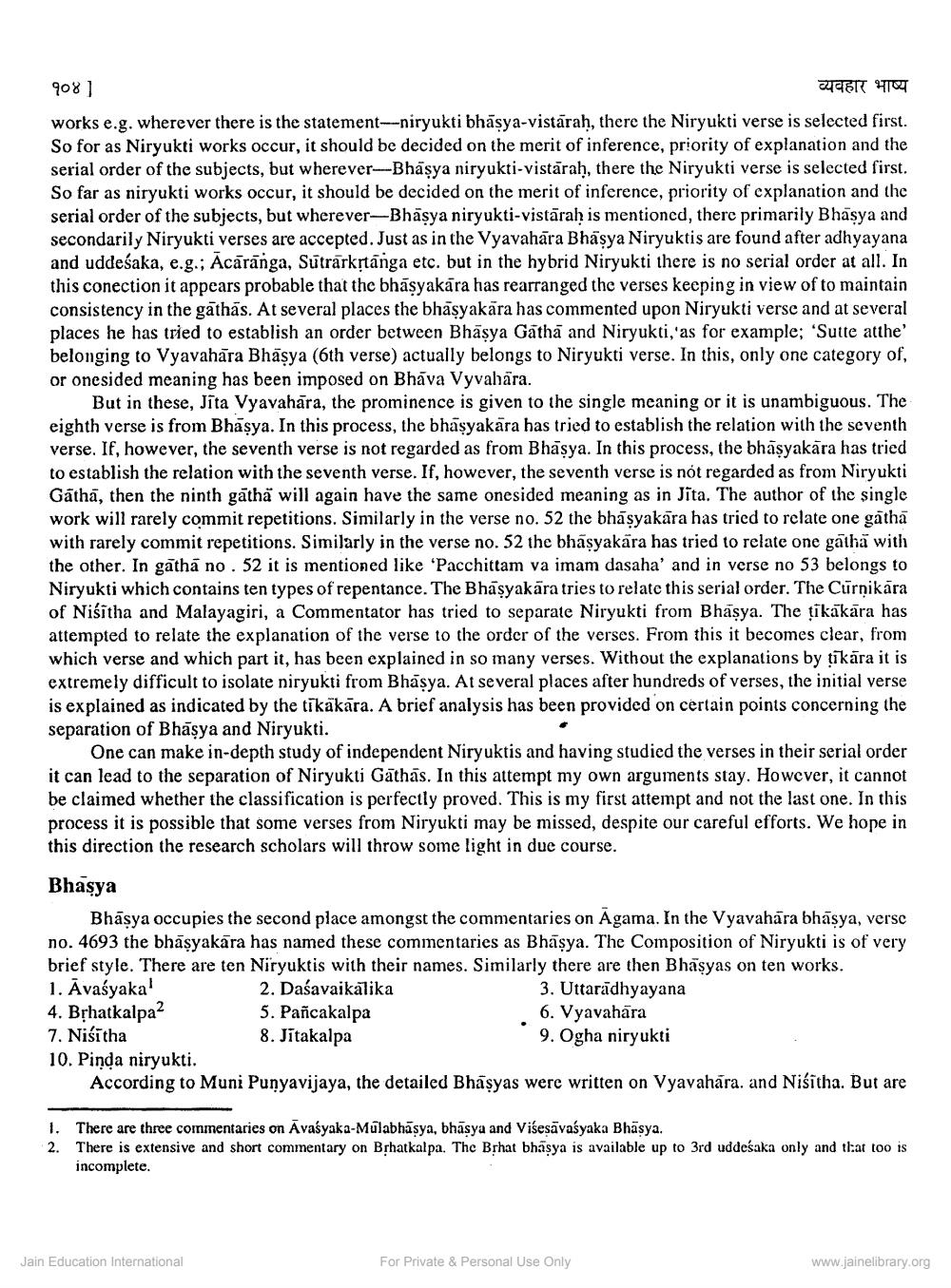________________
908)
व्यवहार भाष्य works e.g. wherever there is the statement-niryukti bhāsya-vistarah, there the Niryukti verse is selected first. So for as Niryukti works occur, it should be decided on the merit of inference, priority of explanation and the serial order of the subjects, but wherever-Bhasya niryukti-vistarah, there the Niryukti verse is selected first. So far as niryukti works occur, it should be decided on the merit of inference, priority of explanation and the serial order of the subjects, but wherever-Bhasya niryukti-vistārah is mentioned, there primarily Bhasya and secondarily Niryukti verses are accepted. Just as in the Vyavahāra Bhāsya Niryuktis are found after adhyayana and uddeśaka, e.g.; Ācāranga, Sūtrarkņtānga etc. but in the hybrid Niryukti there is no serial order at all. In this conection it appears probable that the bhāsyakāra has rearranged the verses keeping in view of to maintain consistency in the gathas. At several places the bhasyakāra has commented upon Niryukti verse and at several places he has tried to establish an order between Bhasya Gatha and Niryukti,'as for example; 'Sutte atthe belonging to Vyavahāra Bhāşya (6th verse) actually belongs to Niryukti verse. In this, only one category of, or onesided meaning has been imposed on Bhāva Vyvahāra.
But in these, Jīta Vyavahāra, the prominence is given to the single meaning or it is unambiguous. The eighth verse is from Bhasya. In this process, the bhāsyakāra has tried to establish the relation with the seventh verse. If, however, the seventh verse is not regarded as from Bhāsya. In this process, the bhāșyakāra has tried to establish the relation with the seventh verse. If, however, the seventh verse is not regarded as from Niryukti Gathā, then the ninth gātha will again have the same onesided meaning as in Jita. The author of the single work will rarely commit repetitions. Similarly in the verse no. 52 the bhāsyakära has tried to relate one gatha with rarely commit repetitions. Similarly in the verse no. 52 the bhasyakāra has tried to relate one gatha with the other. In gathā no. 52 it is mentioned like 'Pacchittam va imam dasaha' and in verse no 53 belongs to Niryukti which contains ten types of repentance. The Bhasyakāra tries to relate this serial order. The Curnikára of Niśitha and Malayagiri, a Commentator has tried to separate Niryukti from Bhasya. The tikākāra has attempted to relate the explanation of the verse to the order of the verses. From this it becomes clear, from which verse and which part it, has been explained in so many verses. Without the explanations by tīkāra it is extremely difficult to isolate niryukti from Bhasya. At several places after hundreds of verses, the initial verse is explained as indicated by the tikākāra. A brief analysis has been provided on certain points concerning the separation of Bhāsya and Niryukti.
One can make in-depth study of independent Niryuktis and having studied the verses in their serial order it can lead to the separation of Niryukti Gathās. In this attempt my own arguments stay. However, it cannot be claimed whether the classification is perfectly proved. This is my first attempt and not the last one. In this process it is possible that some verses from Niryukti may be missed, despite our careful efforts. We hope in this direction the research scholars will throw some light in due course.
Bhasya
Bhāsya occupies the second place amongst the commentaries on Agama. In the Vyavahāra bhāsya, verse no. 4693 the bhāsyakāra has named these commentaries as Bhasya. The Composition of Niryukti is of very brief style. There are ten Niryuktis with their names. Similarly there are then Bhasyas on ten works. 1. Avaśyaka' 2. Dasavaikalika
3. Uttaradhyayana 4. Bțhatkalpa? 5. Pancakalpa
6. Vyavahāra 7. Niśītha 8. Jītakalpa
9. Ogha niryukti 10. Pinda niryukti.
According to Muni Punyavijaya, the detailed Bhāşyas were written on Vyavahāra, and Niśitha. But are
1. There are three commentaries on Avaśyaka-Mulabhasya, bhasya and Visesavaśyaka Bhāsya. 2. There is extensive and short commentary on Brhatkalpa. The Brhat bhâsya is available up to 3rd uddesaka only and that too is
incomplete.
Jain Education International
For Private & Personal Use Only
www.jainelibrary.org




